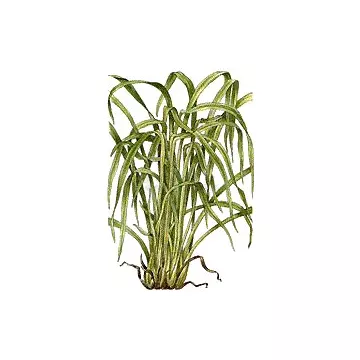What is citronella?
Lemongrass is a tropical herbaceous plant, recognizable by its long, fibrous stems and fresh, lemon-like fragrance. It belongs to the Poaceae (grass) family, like sugarcane or bamboo. Its subtle, lemony taste makes it an ingredient of choice in many Asian cuisines, while its aroma is widely appreciated in perfumery and mosquito repellent products.
Where does lemongrass come from?
Lemongrass originated in Southeast Asia, where it has been cultivated for centuries for its aromatic and therapeutic qualities. It gradually spread to other tropical and subtropical regions, including parts of Africa, Latin America and the Pacific. Its cultivation requires a warm, humid climate, well-drained soil and generous sunshine, ideal conditions for the full development of its essential oils.
What does it look like?
Lemongrass consists of long, thin, rigid stems, generally pale green or gray-green in color. Each of these stems forms a bulb at the base, which is more bulbous and concentrates much of its aroma. The sharp, tapering leaves give off a lemony fragrance when crumpled. We mainly use the lower, softer part of the stem, which releases its full flavor when finely chopped or crushed.
What are its main constituents?
- Essential oils: Lemongrass is especially rich in citral and geraniol, responsible for its characteristic scent and insect-repellent properties.
- Polyphenols: They exert an antioxidant action, helping the body to fight free radicals.
- Fibers: Essential for digestion, they contribute to a feeling of satiety, although the lemongrass stalk is often removed before eating.
- Minerals and vitamins: small amounts of potassium, magnesium and B vitamins are present, although these are not a significant part of the daily intake.
What are its potential benefits?
- Soothing properties: Lemongrass infusions are recognized for their calming properties, contributing to relaxation and rest.
- Aids digestion: Some people appreciate its stimulating action on transit, with a potentially beneficial effect on bloating.
- Insect repellent power: Its essential oil is widely used to repel mosquitoes, thanks to its lemony fragrance, which is little appreciated by insects.
- Antioxidant action: The polyphenols present may help protect cells from oxidation.
- Culinary use: Beyond its health benefits, lemongrass lends a delicate, exotic fragrance to many dishes.
Can it be used outside the kitchen?
Yes, lemongrass has many everyday uses:
- Essential oil: diffused into the air, it helps repel insects and provides a refreshing ambience.
- Cosmetics: Some skincare products use citronella for its energizing fragrance and purifying properties.
- Candles and sprays: Their lemony scent is highly effective in keeping mosquitoes at bay on summer evenings.
What precautions should I take?
- Allergies: Skin or respiratory reactions to citronella essential oil are rare, but possible. It's best to test a small area of skin before use.
- Internal use: As an infusion or in cooking, lemongrass presents no particular risk, unless consumed in excess.
- Pregnant women and children: As a precaution, the use of essential oils is generally not recommended or limited during pregnancy and with young children. Consult a professional if in doubt.
How to select and store citronella?
- Appearance: Stems should be firm, bright green with no brown or black spots. The base should be slightly swollen, a sign of freshness.
- Odor: Simply rubbing the stem should release a lemony scent.
- Storage: Lemongrass can be stored in an airtight bag in the fridge for a few weeks. It can also be frozen in sections for several months.
Can lemongrass be grown at home?
Yes, lemongrass can be grown in a pot or in a garden, provided it enjoys sunny exposure and well-drained soil. It thrives in warm climates, but can be protected during winter in cooler regions. Indoors, place near a bright window and water regularly, but avoid overwatering.
